Pre-Workout Warm-Up Routine…
Prior to hitting the gym floor for your actual weight-training routine, you should take some time to warm-up and mentally prepare yourself for the workout that’s to follow. In this section I’m going to outline my personal pre-workout “warm-up ritual” that I do at the beginning of each and every workout.
Cardio Warm Up…
I’ll start my workout with 5-10 minutes of moderate intensity cardio that moves the total body. My personal favorite warm-up cardio is using the rower or the elliptical machine with the moving arm handles. This will help circulate blood flow throughout the entire body, increase your core temperature, and get a light sweat going.
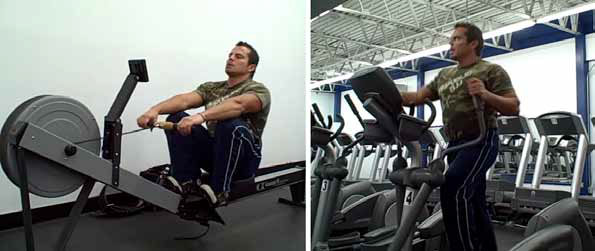
Now if you don’t have a rower or elliptical at your gym don’t worry about it, just use whatever cardio machines you have available. The main thing is to simply elevate your core temperature and work up a light sweat.
Joint Mobility Warm Up…
After the cardio warm up, I’ll go through the following series of exercises to warm-up all my shoulders, elbows, core, hips, etc.
Arm Circles: 20 rotations forward and 20 rotations backwards (repeat 2 times).
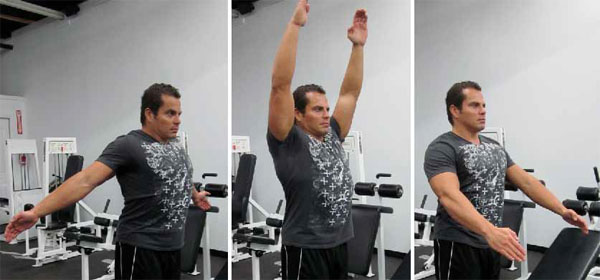
Rotator Cuff Rotations: 2 sets of 20 reps using 5 pound dumbbells.
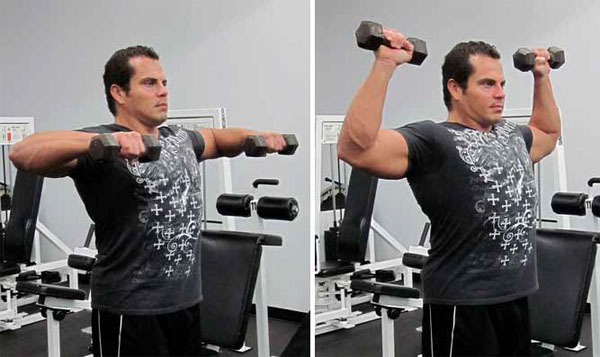
External Rotator Cuff Rotations: 2 sets of 20 reps using 5 pound dumbbells.
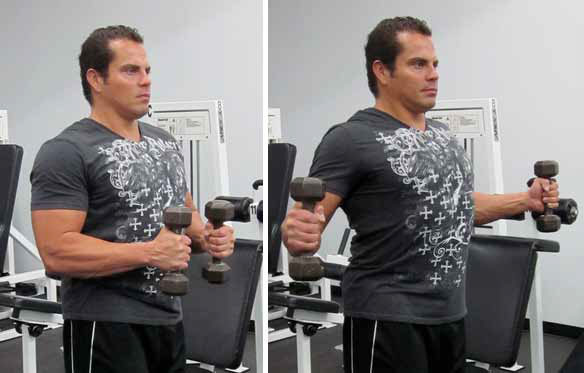
Standing Dumbbell Flyes: 2 sets of 20 reps using 5 pound dumbbells.
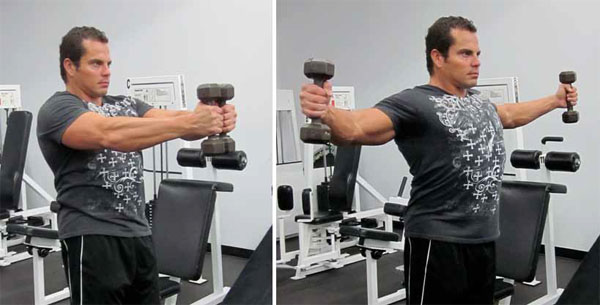
Diagonal Dumbbell Flyes: 2 sets of 20 reps using 5 pound dumbbells (each side).
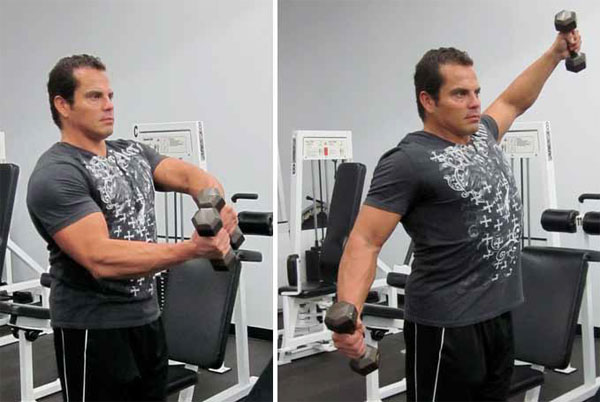
Twisting From Side To Side: 2 sets of 20 reps.
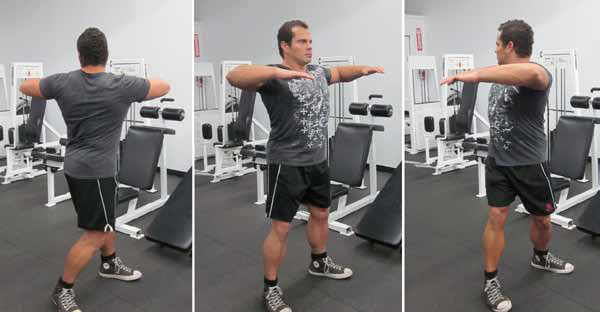
Bodyweight Squats: 2 sets of 20 reps.
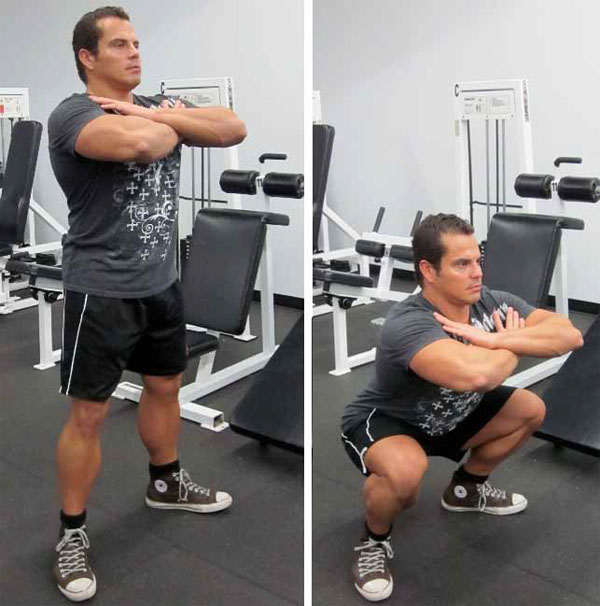
You’ll notice that I do a fair bit of warm-up for the shoulders / rotator cuff here. The reason for this is because shoulder injuries are quite common in the gym, and the main cause is simply not warming up properly before lifting heavy weights.
Your shoulders are a very critical area. They are involved with virtually every upper body exercise you do. Plus they also come into play with a lot of lower body exercises as well. For example, holding a barbell across your back while squatting and grabbing a barbell while deadlifting places a lot of stress on the shoulders in a static contraction. If you suffer a shoulder injury it can literally hamper your workouts for all bodyparts. So it’s best to play it safe and warm-up properly before lifting.
After this “warm-up ritual” I’ll move into the actual scheduled workout routine for that day. But even though I’ve already done the cardio and the warm-up exercises listed above, I’ll still start off light for each and every weight training exercise and do as many progressively heavier warm-up sets as I feel I need before moving to my top working weight.
You should NEVER skip on your warm-ups. Granted they will add an extra 10 or 20 minutes or so to your workout time. But if you don’t do them and get injured, you could be unable to workout for several weeks while you are laid up and recovering from that injury. So make sure that you ALWAYS take the time to do a proper warm-up.
Progressively Heavier Warm-Up Sets…
There is a lot of confusion when it comes to doing warm-up sets. While most workout programs are very detailed in outlining the actual workout routine itself, they are usually very vague when it comes to talking about warm-up sets. The general description for warm-ups is simply “Do as many warm-up sets as you feel you need.” The problem is that most people don’t really know how many warm-up sets they need.
I’ll often get asked questions such as:
- How many warm-up sets do you have to do?
- How much weight do you lift for a warm-up set?
- Do you have to do a warm-up for every single exercise?
- Etc…
And just like with a lot of things, there is no right or wrong answer to those questions. It’s going to vary from person to person as well as from exercise to exercise. But I’m going to outline some general warm-up set guidelines that you can start with and as you get more experienced you can customize them based on your results.
One thing you need to understand is that the more advanced you get, the more warm-up sets you’ll need. Just think about it; the more advanced you are, the stronger you are, and the more force you are able to generate.
For example, an advanced bodybuilder who can squat 400 pounds is going to need to perform a lot more warm-up sets than a novice who can only squat 100 pounds. The heavier you lift, the more warm-up sets you need to do. This also applies to the different exercises you do within your actual workout. You’ll need a lot more warmup sets for a 300 pound deadlift than you will for a 30 pound dumbbell curl.
I’m going to give you some sample numbers from my own personal workouts. This way you can get an idea of how I go about my warm-up sets and how I transition from light warm-up sets, to progressively heavier warm-up sets, and up to my top working weight sets. Now obviously the weights listed are just for example purposes. The weights you lift in your own workouts may be lower (or higher) depending on your personal strength levels.
| Sample Bench Press Workout Warm-Up: – Empty Bar X 10 reps (light warm up set) – 95 pounds X 10 reps (light warm up set) – 135 pounds X 10 reps (light warm up set) – 185 pounds X 5 reps (moderate warm up set) – 225 pounds X 5 reps (heavy warm up set) – 275 pounds X 5 reps (top working weight) |
I work my way up doing several progressively heavier warm-up sets until I get up to my top working weight. You’ll notice that when I get to the “moderate warm-up sets” I actually drop my reps down to 5 per set. This is to conserve energy for my top weight working sets. I still want to warm-up to prevent injury, but I don’t want to tire myself out, so I’ll keep the reps low.
Once I get to my top weight, I’ll do my working sets; 3 sets of 10 reps, 5 sets of 5 reps, etc. or what ever my scheduled workout is for that day.
| Sample Squat Workout Warm-Up: – Empty Bar X 10 reps (light warm up set) – 95 pounds X 10 reps (light warm up set) – 135 pounds X 10 reps (light warm up set) – 185 pounds X 10 reps (moderate warm up set) – 225 pounds X 5 reps (moderate warm up set) – 275 pounds X 5 reps (heavy warm up set) – 315 pounds X 5 reps (top working weight) |
Again, I’ll use a similar pattern here as I did with the bench press. But because it is a heavier exercise I’ll do more warm-up sets.
| Sample Deadlift Workout Warm-Up: – Empty Bar X 10 reps (light warm up set) – 95 pounds X 10 reps (light warm up set) – 135 pounds X 10 reps (light warm up set) – 225 pounds X 10 reps (light warm up set) – 275 pounds X 5 reps (moderate warm up set) – 315 pounds X 5 reps (moderate warm up set) – 365 pounds X 5 reps (heavy warm up set) – 405 pounds X 5 reps (top working weight) |
The weights increments used in these examples go along with the standard weights used at most commercial gyms. 45 pound barbells, 45 pound weight plates, 25 pound weight plates, etc. You can adjust your own personal warm-up set weights accordingly. However, everyone should start with an empty bar warm-up set and then perform several progressively heavier warm-ups until you get up to your top working weight.
You can perform these warm up sets in a fairly fast pace. You won’t need to take long rest periods between sets, especially for the lighter sets, as they will not be physically exhausting. But as you get into your heavier warm-up sets you may want to take a minute or two rest between sets.
Generally most workouts start with the big heavy compound exercises first and then move on to smaller isolation exercises afterwards. With smaller exercises you won’t need to go through as many warm-up sets. The weights lifted will be much lighter and your body will already be physically warmed up by this stage of your workout. The purpose of doing lighter warm-up sets here is to just prepare your body for mechanics of the actual exercise you are going to be doing.
Most people feel stronger on their 2nd set of an exercise. During your 1st set you may have lots of energy, but you are not totally in the groove of doing the exercise. By the time you do your 2nd set your body is in the groove of the movement and you’ll generally feel stronger. Then with each set after that, fatigue comes into play and your strength will gradually decline as you muscles get tired.
So getting your body comfortable with the exercise mechanics is another reason for doing lighter warm-up sets. This way you’ll get in the groove of the exercise with a lighter warm-up set and then be able to go 100% with your actual working weight sets.
This is how my weights may go when warming up for smaller exercises…
| Sample Dumbbell Curl Workout Warm-Up: – 20 pound dumbbells X 10 reps (light warm up set) – 30 pound dumbbells X 10 reps (moderate warm up set) – 40 pound dumbbells X 10 reps (top working weight) |
| Sample Seated Cable Row Workout Warm-Up: – 100 pounds X 10 reps (light warm up set) – 150 pounds X 10 reps (moderate warm up set) – 200 pounds X 10 reps (top working weight) |
Once you are in the middle of your workout and physically warmed up, all you need to do is perform a quick warm-up set with approx. 50% of your top weight, another warm-up set with approx. 75% of your top weight, and then move right into your top working weight for that exercise. This will be plenty to get your body in the groove of the exercise and give it your all for the actual heavy working sets.
If you strictly follow these guidelines for doing progressively heavier warm-up sets during your workouts you’ll greatly reduce your risk of injury. You’ll also improve your lifting technique and enhance the overall results from your weight training workouts.
If you have any questions or comments about how to properly warm up before working out,
please post them in the forum and we’ll chat there 🙂